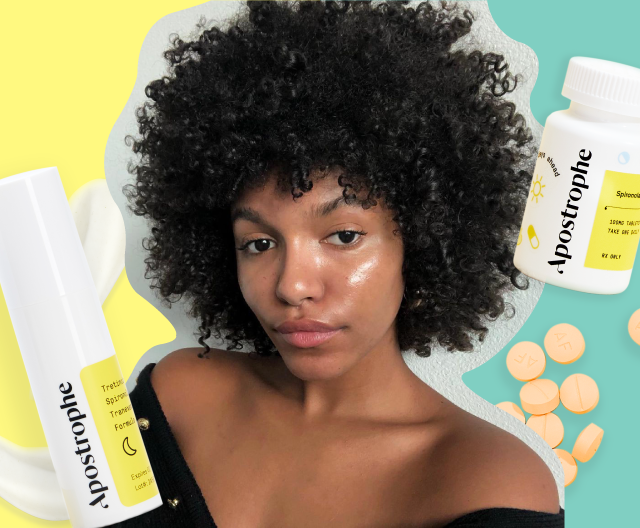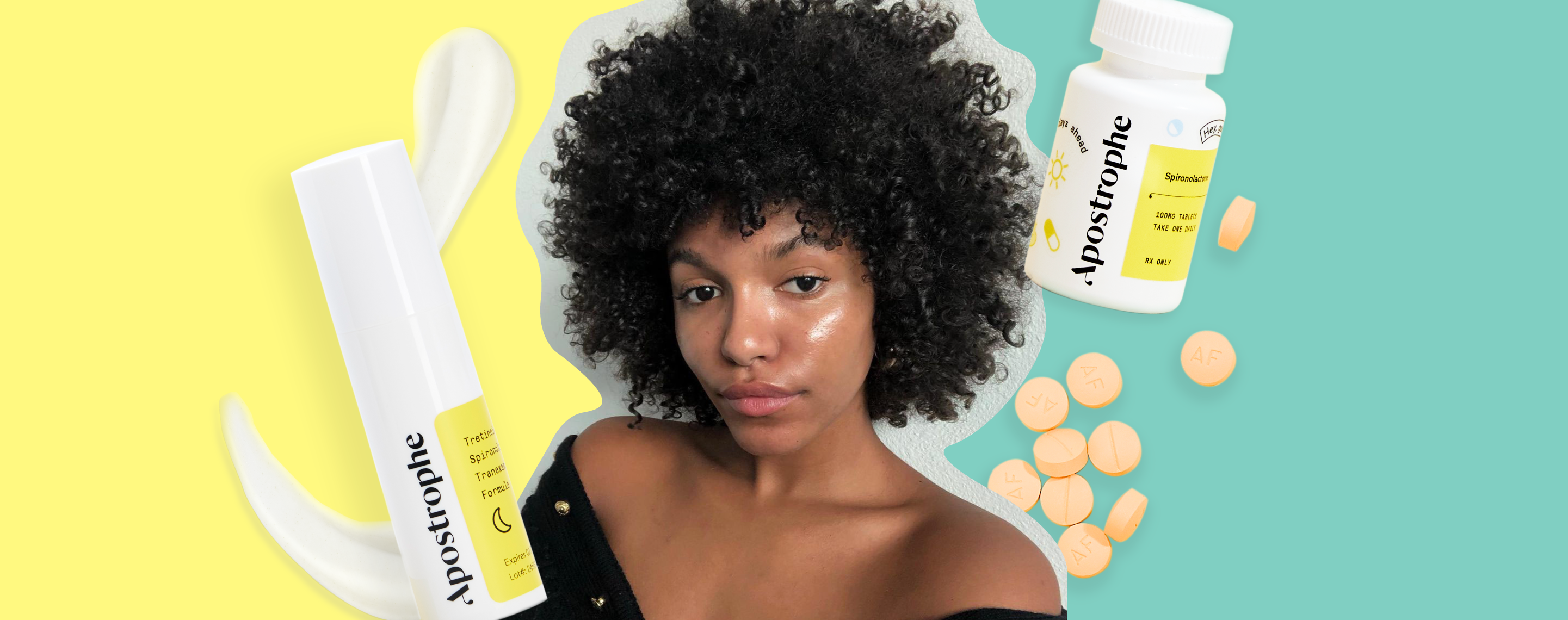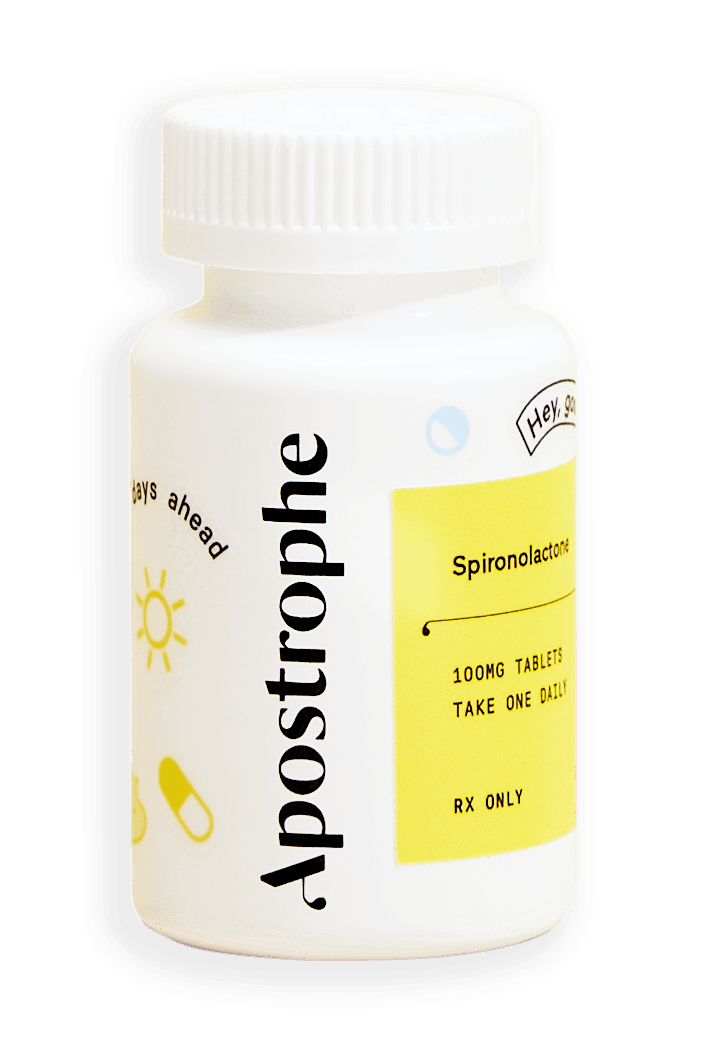Apostrophe Treatments
Oral vs Topical Spironolactone


SHARE
Apostrophe Treatments
Oral vs Topical Spironolactone
Medically reviewed by Aimee Paik, MD
Written by Annie Lam
Last updated 8/4/2024
When it comes to treating hormonal acne, one medication is a tried and true - spironolactone. While oral spironolactone is a dermatologist-favorite, it unfortunately can’t be used by everyone. Enter topical spironolactone - a hormonal acne treatment that is widely available exclusively through Apostrophe! While both oral and topical spironolactone treat the hormonal causes of acne, there are a lot of differences between the two.
What is Spironolactone and how does it treat acne?
Hormonal acne is caused by an imbalance of androgens (a class of hormones). Oral spironolactone is a medication that helps treat hormonal acne by decreasing testosterone levels and blocking androgen receptors. This helps to balance sebum production and decrease acne-causing bacteria.
Did you know? Spironolactone is a diuretic that is actually used to be used to treat high blood pressure. While it’s not the most effective blood pressure medication, its antiandrogenic effects make it a great option for treating hormonal acne.
Oral vs Topical Spironolactone
Now that we know what spironolactone is, let’s talk about the differences between oral and topical spironolactone. They both treat the hormonal causes of acne but work in different ways. Here are some answers to FAQs about oral and topical spironolactone:
Who can use them?
Oral spironolactone is typically only prescribed to cis-women or trans-women to treat hormonal acne. Cis-men and patients sensitive to oral medications are not the best candidates for oral spironolactone.
Topical spironolactone has no systemic side effects, so it can be used by anyone - regardless of age, sex, or gender. Our topical spironolactone treatments cannot be used during pregnancy, but our derms are able to craft an alternative treatment plan that’s safe for you.
What do they treat and how effective are they?
Both oral and topical spironolactone treat hormonal acne and help to balance excess sebum production. They both take anywhere from 8-12 weeks to start seeing results.
Oral spironolactone works from the inside out to treat the hormonal causes of acne. Higher doses of oral spironolactone are considered more effective than its topical form.
Topical spironolactone works at the skin level to treat the hormonal causes of acne. It can take time to take effect, so it isn’t considered as effective as higher doses of oral spironolactone.
Can they be used together?
Yes! Topical spironolactone is a great complement to systemic treatments like oral spironolactone and can ultimately reduce the amount of oral medication needed.
If you're currently taking oral spironolactone and want to switch over to topical spironolactone, your derm may encourage you to not quit cold turkey, as it could impact the results you're seeing. It's important to remember that transitioning off of oral spironolactone, especially higher doses, may take time.
What are the side effects?
Oral spironolactone is a diuretic, so it will cause an increase in urination. It may cause dehydration and lightheadedness if you do not drink enough fluids. Breast tenderness and menstrual spotting may occur, especially at higher doses. There is a possibility of birth defects if you become pregnant while on oral spironolactone. It’s important to avoid pregnancy while taking spironolactone. It may also cause high potassium levels in patients with predisposing risk factors, like older age or underlying kidney problems. In young and healthy patients, this is rarely an issue.
Topical spironolactone is not absorbed into the blood and has no systemic side effects, so it can be used by everyone. Our topical spironolactone formulas are combined with tretinoin, so they cannot be used while pregnant. The most common side effects are redness, peeling, and skin sensitivity, which may occur when first starting out on treatment. Our derms recommend starting slowly to adjust to the medication more easily.
type: embedded-entry-inline id: 6jjBTMKPQjrZdta84ncMDw
Is Oral or Topical Spironolactone right for you?
Both oral and topical spironolactone have their place! Oral spironolactone helps to treat hormonal acne from the inside out, while the topical form works on the skin level. Topical spironolactone is a great option for patients who are not able to take oral spironolactone. When it comes to determining if oral or topical spironolactone is right for you, we recommend consulting with a dermatologist or other healthcare provider. They’ll be able to review your medical history, photos, and skin concerns to create a custom treatment plan that’s right for you.
Shop this post

Oral Spironolactone

Topical Spironolactone
Like what you just read? Sign up for our email list to get the scoop on skincare science delivered straight to your inbox.

Deep Dives
A dermatologist shares his thoughts on the recent studies about benzoyl peroxide and benzene.
Read More
Education
What is milia?
What is milia? Today, we’re jumping into one type of bump that you may have heard about most commonly in infants — milia.
Read More
Education
Best moisturizer for acne-prone skin
If you have combination acne-prone skin, figuring out which moisturizer is best for your skin might be tough. In this guide, we break down the best moisturizer for combination, acne-prone skin.
Read More